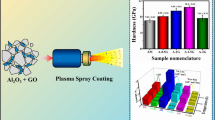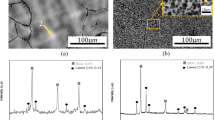Abstract
The microstructure evolution of a platinum-modified nickel-aluminide coating on single-crystal nickel-based superalloy was investigated for various thermal cycling and thermo-mechanical fatigue (TMF) conditions in air for a long-term exposure. An increase in roughness and in β→γ′ transformation rate depends similarly on maximum temperature, holding time at maximum temperature and applied stress. Moreover, the evolution of the interdiffusion zone (IDZ) is analyzed by making the distinction between two layers, according to the major phases observed within these layers, namely β-(Ni,Pt)Al and γ′-Ni3Al. This distinction highlighted that the respective thickness evolution of these two layers are sensitive to each parameter of TMF tests with similar increase in evolution rate when increasing time, temperature, as well as applied stress. The distinctive features of phase transformation are finally discussed together with localization of phase transformation and measured evolution of phase transformation within the external coating and β- and γ′-IDZ layer thicknesses under thermal and thermo-mechanical fatigue. This analysis leads to a conclusion that grain boundaries within the external coating as well as interfaces, between thermally grown oxide, external coating, and IDZ, respectively, play a major role in diffusion, phase transformation, and microstructure evolution of typical platinum-modified nickel-aluminide coating.












Similar content being viewed by others
References
M. S. Farrell, D. H. Boone, and R. Streiff: Surf. Coat. Technol., 1987, vol. 32, no. 1, pp. 69-84.
B. A. Pint, I. G. Wright, W. Y. Lee, Y. Zhang, K. Pruessner, and K.B. Alexander: Mater. Sci. Eng., A, 1998, vol. 245, no. 2, pp. 201-211.
J. Benoist, K.F. Badawi, A. Malié, C. Ramade: Surf. Coat. Technol., 2004, vol. 182, pp. 14-23.
J. Angenete, K. Stiller: Mater. Sci. Eng., A, 2001, vol. 316, no.1, pp. 182-194.
J. Angenete, K. Stiller, E. Bakchinova: Surf. Coat. Technol., 2004, vol. 176, no. 3, pp. 272-283.
F. Pedraza, A. D. Kennedy, J. Kopecek, and P. Moretto: Surf. Coat. Technol., 2006, vol. 200, no. 12, pp. 4032-4039.
E. Basuki, A. Crosky, B. Gleeson: Mater. Sci. Eng., A, 1997, vol. 224, pp. 27-32.
J. A. Nesbitt: Oxid. Met., 1995, vol. 44, no. 1-2, pp. 309-338.
L. Rémy, A. Alam, and A. Bickard: ASTM STP, 2003, vol. 1428, pp. 98-111.
N. Vialas and D. Monceau: Oxid. Met., 2006, vol. 66, no 3-4, p. 155-189.
H.E. Evans: Surf. Coat. Technol., 2011, vol. 206, pp. 1512–21.
S. Darzens, D.R. Mumm, D. R. Clarke, and A. G.Evans: Metall. Mater. Trans. A, 2003, vol. 34, pp. 511-522.
C. Guerre, L. Rémy, and R. Molins: Mater. at High Temp., 2003, vol. 20, no 4, p. 481-485.
C. Duhamel, M. Chieux, R. Molins, and L. Rémy: Mater. at High Temp., 2012, vol. 29, no 2, p. 136-144.
J.L. Malpertu and L. Rémy: Metall. Trans. A, 1990, vol. 21A, pp.389-399.
E. Fleury and L. Rémy: Metall. Mater. Trans. A, 1994, vol. 25A, pp. 99–109.
J. Bressers, D.J. Arrell, K. Ostolaza, J.L. Vallés : Mater. Sci. Eng. A, 1996, vol. 220, no 1, p. 147-154.
P. Moretto and J. Bressers: J. Mater. Sci. 1996, vol. 31, pp. 4817– 29.
T.C. Totemeier, W.F. Gale, and J.E. King: Mater. Sci. Eng. A, 1993, vol. A169, pp. 19–26.
T.C. Totemeier, W.F. Gale, and J.E. King: Metall. Mater. Trans. A, 1996, vol. 27A, pp. 363–69.
O. Franke, K. Durst, M. Göken: Mater. Sci. Eng., A, 2007, vol. 467, no. 1, pp. 15-23.
P.K. Wright: Mater. Sci. Eng., 1998, vol. A245, pp. 191-200.
M. Bartsch, B. Baufeld, S. Dalkilic, L. Chernova, and M. Heinzelmann: Int. J. Fatigue, 2008, vol. 30, no. 2, pp. 211-218.
A.G. Evans, M.Y. He, A. Suzuki, M. Gigliotti, B. Hazel, and T.M. Pollock: Acta Mater., 2009, vol. 57, no. 10, pp. 2969-2983.
L. Rémy, C. Guerre, I. Rouzou, R. Molins: Oxid. Met., 2014, vol. 81, no 1-2, p. 3-15.
F. Riallant, J. Cormier, A. Longuet, X. Milhet, and J. Mendez: Metall. Mater. Trans. A, 2014, vol. 45, no. 1, pp. 351-360.
Y.H. Zhang, D.M. Knowles, and P.J. Withers: Surf. Coat. Technol., 1998, vol. 107, no 1, p. 76-83.
R. Nützel, E. Affeldt, M. Göken: Int. J. Fatigue, 2008, vol. 30, no. 2, pp. 313-317.
L. Rémy, H. Bernard, J.L. Malpertu, and F. Rezai-Aria: in ASTM STP 1186, H. Sehitoglu, ed., ASTM, Pennsylvania, 1993, pp. 3–16.
M. Brunner, M. Bensch, R. Völkl, E. Affeldt, and U. Glatzel: Mater. Sci. Eng., A, 2012, vol. 550, pp. 254-262.
J. Benoist, K.F. Badawi, A. Malié, and C. Ramade: Surf. Coat. Technol., 2004, vol. 182, no. 1, pp. 14-23.
D.K. Das: Prog. Mater. Sci., 2013, vol. 58, pp. 151-182.
C. M. F. Rae, M. S. Hook, and R. C. Reed: Mater. Sci. Eng., A, 2005, vol. 396, no. 1, pp. 231-239.
V. Maurel, L. Rémy, M. Harvey, H. Tezenas du Montcel and A. Koster: Surf. Coat. Technol., 2013, vol. 215, pp. 52-61.
L. C. Zhang and A. H. Heuer: Metall. Mater. Trans. A, 2005, vol. 36, no. 1, pp. 43-53.
V. K. Tolpygo and D. R. Clarke: Acta Mater., 2004, vol. 52, no. 17, pp. 5115-5127.
V. K. Tolpygo and D. R. Clarke: Scr. Mater., 2007, vol. 57, no. 7, pp. 563-566.
H. J. Kolkman: Mater. Sci. Eng., 1987, vol. 89, pp. 81-91.
A.G. Evans, D.R. Mumm, J.W. Hutchinson, G.H. Meier, and F.S. Pettit: Progr. Mater. Sci., 2001, vol. 46 (5), pp. 505-53.
Z. Suo, D.V. Kubair, A.G. Evans, D.R. Clarke, D. R., and V. K. Tolpygo: Acta Materialia, 2003, vol. 51(4), 959-74.
E.W. Hart: Acta Metall., 1957, vol. 5, p. 597.
J.E. Bresenham: IBM Syst. J., 1965, vol. 4(1), pp. 25-30.
N. Otsu: IEEE Trans. Sys. Man. Cyber., 1979, vol. 9(1), pp. 62-66.
Acknowledgments
Vladimir Esin (Mines ParisTech) is gratefully acknowledged for his discussions and careful reading of this paper. This work was supported by SNECMA/Safran Group and the French Ministry of Transportation (Direction des Programmes de l’Aviation Civile) which are also acknowledged. The authors are grateful to SNECMA for supplying the coated superalloys and for availability of their experimental facilities.
Author information
Authors and Affiliations
Corresponding author
Additional information
Manuscript submitted November 27, 2014.
Appendix: Image Analysis Methodology
Appendix: Image Analysis Methodology
After image stitching described above, a program has been developed using Matlab® software to determine geometric parameters and microstructure features. Different steps of image analysis are detailed below:
-
1.
Determination of the coating-free surface. The gray-level gradient between the resin used for sample preparation and the coating surface defines the coating surface profile. It is obtained after segmentation, edge detection, and 2D Bresenham smoothing[42];
-
2.
Determination of the β-IDZ/γ′-IDZ interface. The contrast between the β-IDZ and γ′-IDZ layers (gray vs white) defines the interface between these two layers. It is again obtained after segmentation, edge detection, and 2D Bresenham smoothing;
-
3.
Determination of the initial surface of the substrate. The area bounded by the surface profile and the β-IDZ/γ′-IDZ interface, i.e., external coating +β-IDZ layer, is isolated. Alumina grit particles are assumed to correspond to the original sample surface. They are found through gray-level gradient analysis;
-
4.
Determination of the geometrical center of the cross section. The center and the radius of the circle that fit best with these particles are obtained by least square method. This set of geometric parameters defines the reference line;
-
5.
Approximation of the sample surface and β-IDZ/γ′-IDZ interface by circular segments with the center defined in the previous step; measurement of β-IDZ thickness. Using the reference center determined above and using the same optimizing method, the radius of the circle that fits to the surface profile, and to the β-IDZ/γ′-IDZ interface, respectively are calculated. The subtraction of the radius associated with the β-IDZ/γ′-IDZ interface with the reference radius gives the average β-IDZ thickness;
-
6.
Determination of the external coating location and measurement of the surface fraction of the formed γ′-Ni3Al phase, \( {\text{F}}_{\text{s}}^{\gamma \prime } \). The area bounded by the surface profile and the reference line, defines the external coating. The contrast between the β and γ′ phases allows a direct thresholding analysis using Otsu’s method[43]; the number of pixel belonging to the γ′ phases is obtained. The ratio with the total number of pixel contained in the external coating gives the surface fraction of external coating transformed into γ′ phases, i.e., \( {\text{F}}_{\text{s}}^{\gamma \prime } \);
-
7.
Measurement of the γ′-IDZ layer thickness. Finally, the γ′-IDZ layer thickness is evaluated for each cross section manually, measuring the length of segments drawn between the β-IDZ/γ′-IDZ interface and the γ′-IDZ/substrate interface. More than 20 segments are measured for each reconstructed profile.
The different steps and features detected by the program are summarized in Figure 6(c).
Rights and permissions
About this article
Cite this article
Sallot, P., Maurel, V., Rémy, L. et al. Microstructure Evolution of a Platinum-Modified Nickel-Aluminide Coating During Thermal and Thermo-mechanical Fatigue. Metall Mater Trans A 46, 4589–4600 (2015). https://doi.org/10.1007/s11661-015-2857-9
Published:
Issue Date:
DOI: https://doi.org/10.1007/s11661-015-2857-9




